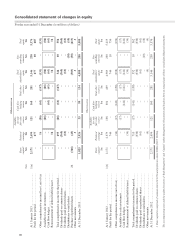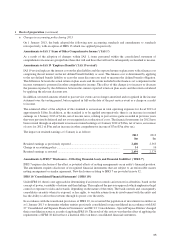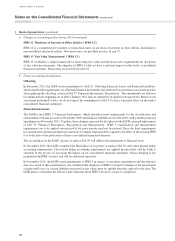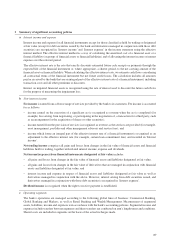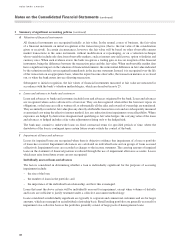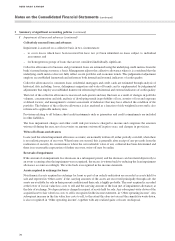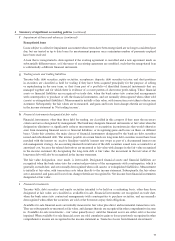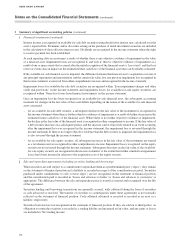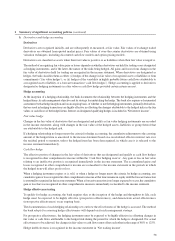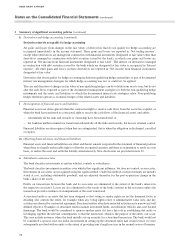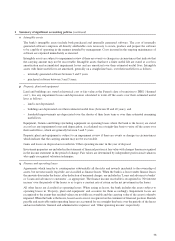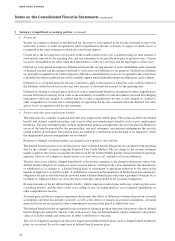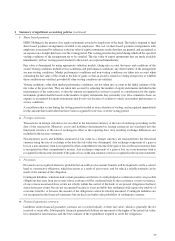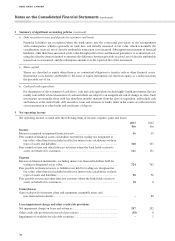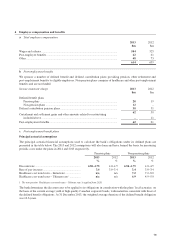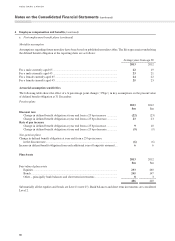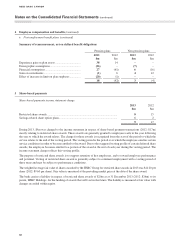HSBC 2013 Annual Report Download - page 74
Download and view the complete annual report
Please find page 74 of the 2013 HSBC annual report below. You can navigate through the pages in the report by either clicking on the pages listed below, or by using the keyword search tool below to find specific information within the annual report.
HSBC BANK CANADA
72
2 Summary of significant accounting policies (continued)
i Financial investments (continued)
Interest income is recognized on available-for-sale debt securities using the effective interest rate, calculated over the
asset’s expected life. Premiums and/or discounts arising on the purchase of dated investment securities are included
in the calculation of their effective interest rates. Dividends are recognized in the income statement when the right
to receive payment has been established.
At each reporting date an assessment is made of whether there is any objective evidence of impairment in the value
of a financial asset. Impairment losses are recognized if, and only if, there is objective evidence of impairment as a
result of one or more events that occurred after the initial recognition of the financial asset (a ‘loss event’) and that loss
event (or events) has an impact on the estimated future cash flows of the financial asset that can be reliably estimated.
If the available-for-sale financial asset is impaired, the difference between the financial asset’s acquisition cost (net of
any principal repayments and amortization) and the current fair value, less any previous impairment loss recognized in
the income statement, is removed from other comprehensive income and recognized in the income statement.
Impairment losses for available-for-sale debt securities are recognized within ‘Loan impairment charges and other
credit risk provisions’ in the income statement and impairment losses for available-for-sale equity securities are
recognized within ‘Gains less losses from financial investments’ in the income statement.
Once an impairment loss has been recognized on an available-for-sale financial asset, the subsequent accounting
treatment for changes in the fair value of that asset differs depending on the nature of the available-for-sale financial
asset concerned:
– for an available-for-sale debt security, a subsequent decline in the fair value of the instrument is recognized in
the income statement when there is further objective evidence of impairment as a result of further decreases in the
estimated future cash flows of the financial asset. Where there is no further objective evidence of impairment,
the decline in the fair value of the financial asset is recognized in other comprehensive income. If the fair value of
a debt security increases in a subsequent period, and the increase can be objectively related to an event occurring
after the impairment loss was recognized in the income statement, the impairment loss is reversed through the
income statement. If there is no longer objective evidence that the debt security is impaired, the impairment loss
is also reversed through the income statement;
– for an available-for-sale equity security, all subsequent increases in the fair value of the instrument are treated
as a revaluation and are recognized in other comprehensive income. Impairment losses recognized on the equity
security are not reversed through the income statement. Subsequent decreases in the fair value of the available-
for-sale equity security are recognized in the income statement, to the extent that further cumulative impairment
losses have been incurred in relation to the acquisition cost of the equity security.
j Sale and repurchase agreements (including securities lending and borrowing)
When securities are sold subject to a commitment to repurchase them at a predetermined price (‘repos’), they remain
on the statement of financial position and a liability is recorded in respect of the consideration received. Securities
purchased under commitments to sell (‘reverse repos’) are not recognized on the statement of financial position
and the consideration paid is recorded in ‘Loans and advances to banks’ or ‘Loans and advances to customers’ as
appropriate. The difference between the sale and repurchase price is treated as interest and recognized over the life
of the agreement.
Securities lending and borrowing transactions are generally secured, with collateral taking the form of securities
or cash advanced or received. The transfer of securities to counterparties under these agreements is not normally
reflected on the statement of financial position. Cash collateral advanced or received is recorded as an asset or a
liability, respectively.
Securities borrowed are not recognized on the statement of financial position. If they are sold on to third parties, an
obligation to return the securities is recorded as a trading liability and measured at fair value, and any gains or losses
are included in ‘Net trading income’.
Notes on the Consolidated Financial Statements (continued)
HSBC BANK CANADA


